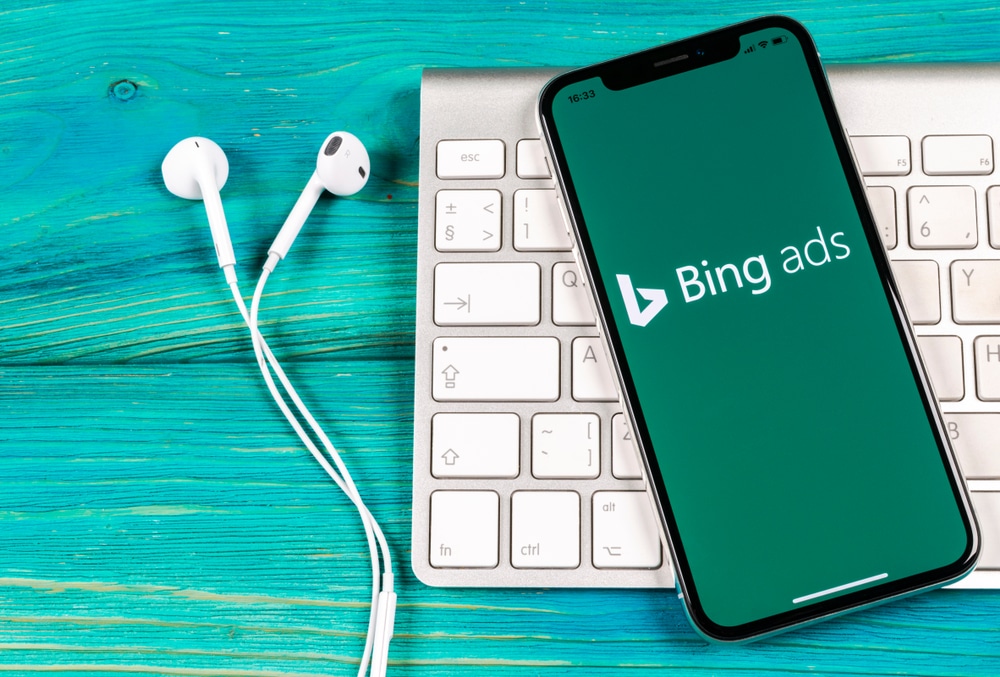As an advertising copywriter for over 20 years, and an internet user for even longer, I’ve seen search engines rise, fall, and evolve. Pre-Google, there were lots of options, but the search results were mixed at best, and completely wrong at worst (with tons of broken links and images). Google changed everything though, and I’ve watched it grow from a search engine into a household name (and verb), and onto being the undisputed behemoth of digital advertising.
But, while everyone’s been focused on this obvious giant, a quieter challenger has been building a network of its own — and you’ve known about it the whole time. That would be Microsoft, and its advertising network, formerly known as Bing Ads. It’s an absolute goldmine that too many marketers are still ignoring, so let’s take a deeper look into it, and see how you can use it to your advantage.
What Are Bing Ads?
At its core, Bing Ads (now officially called Microsoft Advertising) is a paid search advertising platform that allows you to display your ads on the Bing search engine, as well as on Yahoo, AOL, and other partner sites. When someone searches for a keyword you’ve bid on, your ad has a chance to show up on the search results page. It’s not just a copy-and-paste of Google, either: This is a different ecosystem entirely, with different demographics, which ultimately means different opportunities for growth.
How Do Bing Ads Work?
The mechanics will be familiar to anyone who’s used paid search even a little bit. It’s an auction-based system where you bid on keywords. When a user types in a query, the platform runs an auction in seconds, and the winners get their ads displayed. Your ad’s position is determined by its Ad Rank, which is a combination of your bid, your ad’s quality (known as the Quality Score), and other factors like expected click-through rate.
The advantage of Microsoft Advertising specifically, however, lies in its integrations. It’s seamlessly connected to Microsoft’s suite of products, including Windows, Office, and Edge, giving it a colossal reach that other networks simply don’t have. This isn’t just a search engine; it’s a platform that’s built into the very fabric of millions of computers and devices around the world.
Types of Bing Ads
This isn’t a one-size-fits-all experience. Microsoft Advertising offers a variety of ad formats to help you reach your audience wherever they are, such as:
Expanded Text Ads
These are the standard text-based ads you see on search results pages. They’re simple, but they’re a classic for a reason — they work.
Dynamic Search Ads
These ads are automatically generated based on the content of your website. They’re perfect for large e-commerce stores with lots of products that would otherwise take a human team a ton of time. I’ve seen these save countless hours for my clients over the years.
Responsive Search Ads
These are the workhorses of modern paid search. You provide multiple headlines and descriptions, and the platform’s AI mixes and matches them to create the best-performing ad for each user.
Shopping Campaigns
Shopping campaigns are ideal for retailers. These display product images, prices, and store names directly in the search results. Not only that, but they’re visually compelling, and incredibly effective for driving e-commerce sales.
Audience Ads
This is where things get a little more interesting. Audience ads are native ads that appear on sites like MSN and Outlook, and Microsoft Edge, blending in with the surrounding content. They’re designed to capture attention without being obnoxiously flashy, and drive traffic from an engaged audience.
Microsoft Ads Specs
Knowing the limits and boundaries can often help you be more creative. Here’s a quick rundown of the main ad types:
Display
You’ll need different sizes for display banners, with common dimensions like 300×250, 728×90, and 160×600. Keep your file size small to ensure fast loading times.
Native
Microsoft’s native ads, called Audience Ads, are image-based. You’ll typically need a hero image (1200×628) and a small image (300×300), along with a short headline and description. These should be designed to blend into the surrounding content, not be a flashy, distractingly obvious advertisement.
Video
Video ads on Microsoft’s network can vary in length, but they should always be high-quality and optimized for mobile viewing. Short, punchy videos (15-30 seconds) often perform best.
Advantages
So, why even bother with Microsoft Advertising when it seems like everyone’s on Google? It’s true that Google has the continuous spotlight on it, but while people gravitate toward it, there’s lots of hidden gems that live over here:
Less Competition
Fewer advertisers are using Microsoft’s platform, and that’s a good thing for you. This often means lower cost-per-click (CPC) and higher ROI for your campaigns.
High-Value Audience
The Bing audience tends to be older, more educated, and have higher disposable income. This is pure gold for B2B and high-end consumer brands.
LinkedIn Integration
This is a huge advantage. Microsoft owns LinkedIn, which means you can use LinkedIn profile targeting to reach specific job titles, industries, and companies. For B2B clients, this is a non-negotiable part of any strategy.
Google Import
Microsoft’s platform makes it incredibly easy to import your existing Google Ads campaigns. You can literally get a campaign up and running in minutes. This is a huge time-saver and makes testing the platform a no-brainer.
Google Ads vs. Microsoft (Bing) Ads
For the best possible results, it’s not a matter of one or the other; it’s about using them both strategically. Google Ads has a larger audience, but Microsoft Ads has a more specific, high-value one. Google is a massive, bustling city. Microsoft is a smaller, exclusive town.
While Google’s scale is endless and unmatched, Microsoft’s audience targeting and lower cost can make it the most profitable channel in your mix. Think of it this way — Google gets you volume, but Microsoft gets you quality. When building a new campaign, you can test it on both platforms. It’s a simple, low-risk way to maximize your reach and results.
How to Set Up Your Campaign: 5 Steps
Ready to try it out? Here’s a quick guide to getting your campaign live.
1. Set Your Goal
Are you looking for website visits, conversions, or brand awareness? Start with a clear objective and build out from there.
2. Import From Google Ads
Seriously, don’t build it from scratch. Use the import tool: It’s the fastest, easiest way to get started. You can always tweak it later.
3. Keyword Research
Even with an import, take a moment to review your keywords. You might find some less competitive, high-value ones on Bing that you hadn’t considered for Google.
4. Create Your Ads
Write compelling ad copy that speaks directly to your audience, and remember to create multiple variations for testing.
5. Set Your Budget and Bids
Start with a modest budget and a conservative bidding strategy. You can always scale up once you see what’s working.
How to Optimize for Bing Ads
Getting a campaign live is just the beginning. The real work is in the optimization and adjusting along the way.
Optimize for Mobile
Make sure your ads and landing pages are mobile-friendly. Traffic from users on mobile devices is way up across the board, and Microsoft is no different.
Run A/B Tests
Constantly test different headlines, descriptions, and calls-to-action. Small changes can lead to huge improvements, and this also takes the pressure off you having to decide on just one copy option.
Use the Right Tools
Take advantage of automation and analytics tools to make optimization easier and more efficient. Microsoft Advertising offers built-in features like automated bidding, responsive search ads, and audience network extensions that help you maximize performance with less manual effort. Complementary tools for deeper insights and cross-channel optimization for this walled garden environment include:
- Microsoft Clarity – to understand post-click behavior with heatmaps and session recordings.
- Google Analytics – to analyze user journeys and conversion performance across all channels.
- SEMrush or Ahrefs – to uncover keyword opportunities and competitor insights specific to Bing search.
- Optmyzr or WordStream – to automate routine management tasks, from bid adjustments to negative keyword optimization.
Key Takeaways
Microsoft Advertising (Bing Ads) is a high-value, lower-competition platform with a unique, high-income demographic perfect for B2B and niche markets. Its integration with LinkedIn is a game-changer for B2B campaigns.
Frequently Asked Questions (FAQs)
How can I use LinkedIn Profile Targeting to reach specific job titles, industries, and companies, especially for B2B campaigns?
LinkedIn Profile Targeting is an absolute goldmine, especially for B2B advertisers. The process is straightforward: Within your Microsoft Advertising campaign settings, you can select LinkedIn attributes for targeting — and it gets really specific. You can target based on job function (e.g., marketing, sales), industry (technology, healthcare), and even company names. The best part? The data is much more accurate, since it’s based on a user’s professional profile, not just their browsing history.
For a B2B campaign, I’d start with a broad industry or job function and then layer in more specific targeting as you gather up data. For example, if you’re selling marketing software, you can target “Marketing” as a job function and then narrow it down to “technology” as an industry. This helps to ensure your ads are only shown to the professionals who have the authority and budget to make a purchase, creating more of an opportunity to increase your ROI.
What are the best practices for creating compelling Responsive Search Ads on Bing, and how do they differ from Google’s version?
Responsive Search Ads (RSAs) are all about providing the platform’s AI with as many options as possible. For Bing, the best practices are similar to Google, but with a few key differences. First, you need to provide a minimum of five headlines and three descriptions. I always recommend going above and beyond this minimum to give the platform more to work with, plus, as a copywriter, I want to see which of my ideas take hold with a wider audience.
When writing your headlines and descriptions, I recommend focusing on a few things:
- Keywords: Include your main keywords in at least a couple of headlines.
- Benefits: Focus on the benefits of your product or service, not just the features.
- Call-to-Action: Have a strong, clear call-to-action in at least one or two of your descriptions.
The main difference between Bing and Google’s RSAs is going to be the audience. Since Bing’s audience is most likely going to value clarity, I find that direct, benefit-driven copy performs exceptionally well. Avoid overly flashy or jargon-heavy language, as straightforward and honest copy tends to resonate the most.
What’s the best approach to setting Target ROAS or Target CPA on Bing to ensure profitability?
This is maybe the most frequently asked question, and for good reason. Setting a Target ROAS (Return on Ad Spend) or Target CPA (Cost Per Acquisition) is about telling the platform’s AI what you’re willing to pay for a conversion. My best approach is to start with manual bidding or an enhanced CPC strategy for the first few weeks. This allows the campaign to gather data and for you to establish a baseline.
Once you have a good understanding of your average CPA or ROAS, you can switch to an automated bidding strategy like Target CPA or Target ROAS. I recommend setting the initial target slightly higher than your baseline — maybe 10-15% above. This gives the AI room to find profitable conversions without being too restrictive. Then, as the campaign matures and the algorithm learns, you can gradually lower the target to improve profitability.
Remember: The key isn’t to set a Target CPA or ROAS based on what you want it to be, but on what the data tells you is realistic. Let the data lead the way.



